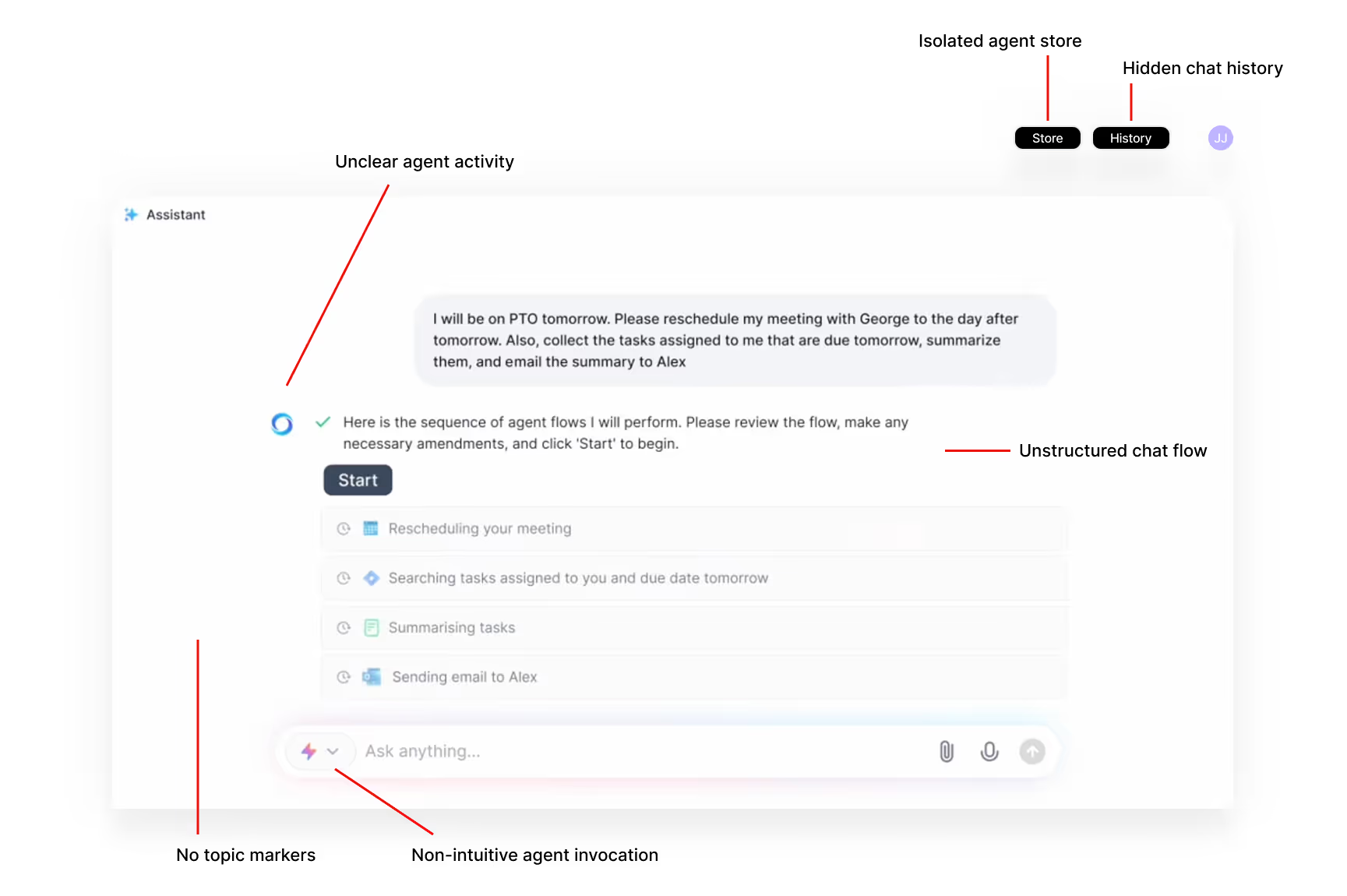A chat-based tool built and designed to help users offload tedious tasks and get more done with the help of AI-powered agents.
Project Guru
Rethinking how people interact with AI by improving conversation structure, and using agents to speed up your workflow.
While the core functionality of the platform was already in place, there wasn't a simple way for users to call on AI agents or interact with them naturally. There also wasn't a system for keeping conversations with these agents organized, making it harder to manage tasks efficiently.
My role was to reimagine how users engage with these agents in conversations. The goal was to create a more structured, intuitive chat experience where users could bring in agents on demand to handle mundane tasks by delegating them to AI instead.

Note: While this project was designed and developed for a real client, I am presenting it here as Project Sentinel, a reimagined case study that reflects my design process without revealing confidential details.
The work showcased is inspired by my role in refining and improving the user experience of an AI-powered agent platform. The details, brands, and examples have been modified for confidentiality while providing insight into my approach to problem-solving and product design.
Challenge
"Navigating conversations shouldn't feel like sorting through a messy inbox."
AI chat tools can be helpful, but they get messy fast. The longer a conversation gets, the harder it is to find something you talked about earlier. And if you bring in AI agents to help with tasks, things can get even more confusing—who handled what? Where do you find that answer again?
I saw an opportunity to make chat work smarter, not harder by fixing three big pain points.
- Making it easier to bring agents into conversations so users could assign tasks or ask for help without creating unnecessary steps to slow down their productivity.
- Adding topic markers to highlight key moments in a discussion so users could quickly jump back to important parts of a chat.
- Making past chats easier to scan by including clear titles, summaries, and agent icons in a chat history.
Existing Chat Interface
Approach
When I started rethinking the experience, my focus was on clarity, navigation, and reducing mental effort. AI chat tools can be useful, but without a clear structure, conversations quickly become overwhelming. I wanted to make it easy to find past discussions, interact with multiple agents naturally, and remove unnecessary friction from the experience.

Current Painpoints for Improvement
Structuring the chat list
I looked at how platforms like ChatGPT and Gemini generate chat titles automatically and explored how a similar approach could improve organization. Instead of leaving conversations as long, unstructured threads, I introduced a way to generate both a title and a short summary for each chat, making it easier to scan past discussions at a glance.
Additionally, I explored visually tagging AI agents within the chat history so users could quickly see which agents were involved in each conversation. This improved layout helps users find relevant information faster without having to dig through long chat logs.

Image of sketches from the chat list explorations go here
Introducing the topic navigator
I wanted to make it easier for users to revisit key points in long conversations. When multiple topics come up in a single thread, scrolling back to find something specific can be frustrating—especially when AI agents are assisting with different tasks.
To solve this, I introduced a Topic Navigator that automatically generates titles for key discussion points. This organizes long conversations into an easy-to-browse panel, eliminating the need for endless scrolling. Users can quickly jump back to previous discussions, making chat history more useful and actionable.

Topic navigator
Simplifying agent interactions
This made working with agents feel less like switching between separate tasks and more like naturally expanding a conversation—similar to adding someone to a group chat.
Improved chat bar & key components
The Solution
In the end, if you’re looking for ways to be more productive and delegate tasks so you can carve out more free time to focus on the things you actually enjoy, then it helps to have a tool that takes repetitive tasks off your plate. With AI agents handling the small stuff, you can spend less time on busywork and more time focusing on other things—whether that’s tackling bigger projects, being creative, or simply having more breathing room in your day.

Improved User Interface
Takeaways
Even in a short timeframe, this project showed me just how important it is that conversations feel more human and are easier to sort through. A great tool isn’t just about what it can do—it’s about how easily people can actually use it.
If I had more time, I would have loved to explore better ways to surface agents in conversations. Right now, they feel helpful, but I think there’s an opportunity to make their presence even more intuitive—like improving visual cues or experimenting with how suggestions appear naturally in a chat. Testing this with real users would have been valuable in shaping how AI fits into everyday workflows.
Final Thoughts
I wasn’t able to see the long-term impact of these changes, but the goal was always clear: help people get more done by making AI-powered conversations easier to manage. AI should make things simpler, not more complicated.
That’s why every decision in this redesign was about cutting through the noise, improving workflow clarity, and making it easier for users to bring AI into their daily tasks without extra hassle.
